Running an e-commerce business is not an easy task. Ensuring its success is even more difficult.
In the highly competitive world of digital marketing, companies have to solve multiple challenges and focus on the right strategies that will help their business thrive.
Online retailers are well aware of how hard it can be to drive traffic and grow sales of their stores in the crowded e-commerce space.
To help businesses figure out what marketing efforts deliver the best results, SEMrush (disclaimer: I work here) conducted an Annual E-commerce Study.
The team analyzed more than 8,000 of the most visited websites of online retailers that represent 13 major industries and operate in different countries, including the U.S., the U.K., Spain, Italy, Germany, and France.
Note: The research does not include data for countries where Google is a secondary search engine (China, Korea, etc.).
The study provides website owners with insights into the best practices of the most successful online retailers. This information can help you make more informed decisions and build a data-driven strategy.
Without further ado, here are eight marketing tips to boost your e-commerce business growth, with some key findings from the study.
1. Step Up Your SEO Game, Using a Tactical Approach
In 2018, search engine optimization should remain one of the key tools in your marketing mix.
According to the study, direct and search traffic accounts for 42.18 percent and 40.1 percent of all e-commerce website traffic, which makes search the second most significant channel for driving traffic among the analyzed sites.
It means that if you don’t have a strong SEO strategy in place, you may fall behind the e-commerce competition and lose out on clicks and sales.
To get more targeted traffic from search, it’s important to use tactics that will help your audience find you.
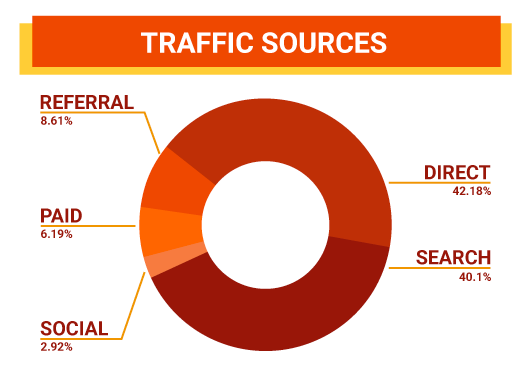
A tactical approach and a smart keyword strategy will help you discover terms and phrases that are highly relevant to your brand and products.
Be sure to use analytics tools to see where most of your traffic and conversions come from.
Instead of catering to search engines, optimize your website with your users in mind and stand out with creative headlines and content.
2. Optimize for Mobile & Maintain a Strong Desktop Presence
According to the data provided by SEMrush, desktop leads mobile in organic search traffic by approximately 14 percent, accounting for 56.98 percent of total e-commerce traffic.
These numbers can be explained by the fact that shoppers still prefer to collect detailed information about products and services on their desktop computers.
Therefore, website owners need to maintain a solid presence in a desktop market. Be sure to build your e-commerce website as a knowledge base for your customers who are interested in learning more about your business and your niche.
However, in the times of global “mobilization,” it’s more important than ever to keep up with today’s realities and searchers’ requirements. Google aims at improving the user experience as much as possible, and thus continues the shift toward mobile-first indexing.
To take advantage of the changes that happen in the industry, website owners should pay attention to what Google encourages them to do and prepare for the mobile-first shift. This is particularly the case with electronics, where mobile organic search traffic is the strongest (44.78 percent of total organic traffic in the electronics industry), compared to other categories.
But don’t jump on the mobile bandwagon just for the sake of it. According to Google, if you only have a desktop site, the search engine will continue to index it as always.
A good desktop-oriented website is better than a poorly performing or broken mobile site. Be sure to build the mobile version of your site properly and roll it out when it’s ready.
3. Reconsider Your PPC Campaign
Even with unique products, to attract shoppers to your online store you need a solid advertising campaign.
To keep your company front and center as shoppers search for your product or service, be sure to amplify your digital marketing strategy with well-targeted paid ads. The data from the research will help you choose the right type of ads that will work for your e-commerce website.
The study shows that the e-commerce industry prefers mobile-friendly HTML display ads over standard media ads (69.68 percent vs. 30.32 percent).
HTML ads are a type of rich media ad that can help businesses effectively deliver their brand message to their audience. If you haven’t included this tool in your PPC arsenal yet, maybe it’s time to consider implementing it, as we see a significant adoption of HTML for online display advertising among the leading e-commerce businesses.
When it comes to the size of display ads, the e-commerce world favors the 728 x 90 ad size, known as a “leaderboard”, used by the majority of your competitors (44.84 percent) and followed by the 300 x 250 (20.95 percent) and 160 x 600 (15.12 percent) ad sizes.
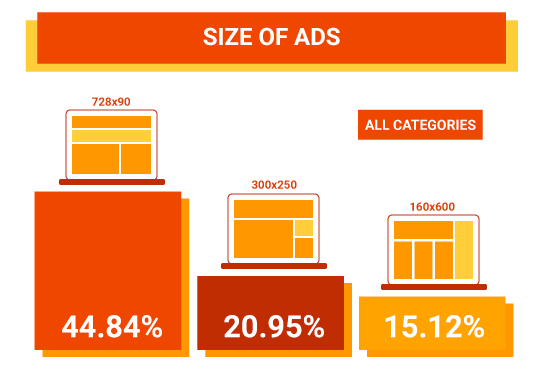
4. Use Powerful Emotional Triggers in Your Ads
Increasing e-commerce conversions is, in many ways, about psychology.
Using the right triggers in your ads helps you better appeal to your target audience’s emotions and win their hearts and minds.
But how to choose the right phrases for your ads and calls to action?
Here’s what the biggest e-commerce websites use in their campaigns to attract the attention of their customers.
It turned out that online businesses tend to point out free delivery options in their ads. The most often used phrases among the e-commerce industries in the U.S. and the U.K. are “free shipping” and “free delivery,” respectively.
The study also shows the most popular guarantee-related phrases that companies use in their ads, since guarantee provided by online stores is one of the most valued benefits for shoppers. “Price guarantee” occupies the first place in both of these countries.
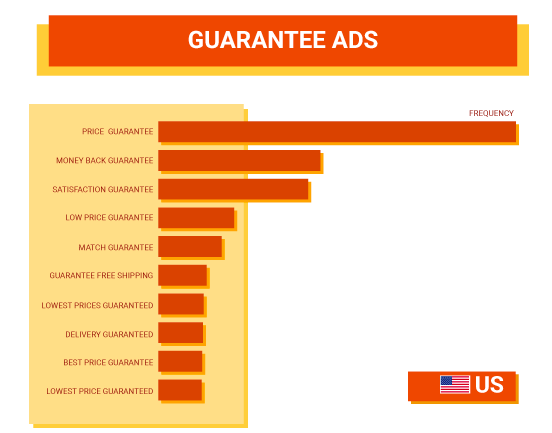
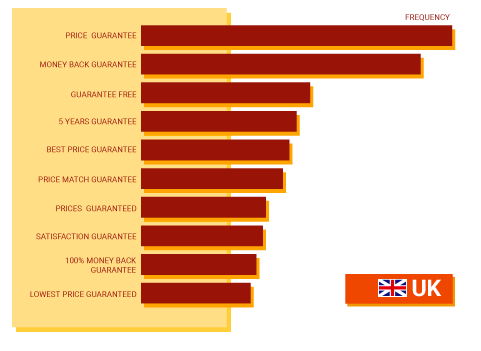
If your ads create a sense of urgency, you’re more likely to compel your customers to perform the desired action.
To make their CTA buttons catchy and persuasive, e-commerce websites use terms like “now” and “today”.
The most frequently leveraged CTA for both the U.S. and the U.K. is “shop now”.
Don’t underestimate the power of emotional triggers, too.
When building your next advertising campaign, try to act on people’s feelings and strengthen your message with the right terms and phrases that will convince your potential customers to act.
5. Consider Offering Free Shipping
People don’t like to pay for delivery. A free shipping option is one of the perks most valued by shoppers.
If your business doesn’t offer free delivery, maybe it’s time to think about adding this option to your website. It can help online businesses boost their sales, as consumers spend 30 percent more per order when a company offers free delivery.
As mentioned above, the biggest e-commerce brands eagerly leverage the “free shipping” phrase in their ads. Therefore, it’s fair to assume they provide their clients with this valuable option.
If you want to keep up with the competition, you need to give your customers what they’re looking for. Otherwise, they might leave your site and find what they want anywhere else.
6. Accumulate More Product Reviews
Product reviews can be an extremely powerful tool for any e-commerce website. They provide social credibility, convincing people to buy from you.
As the data illustrates, reviews are the most prominent of the 15 SERP features analyzed by SEMrush. The reviews feature is displayed in the top 20 results in 57.93 percent of the global SERPs and 62.03 percent of the U.S. SERPs.
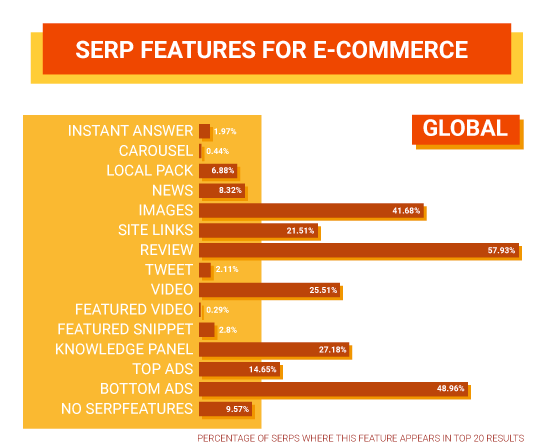
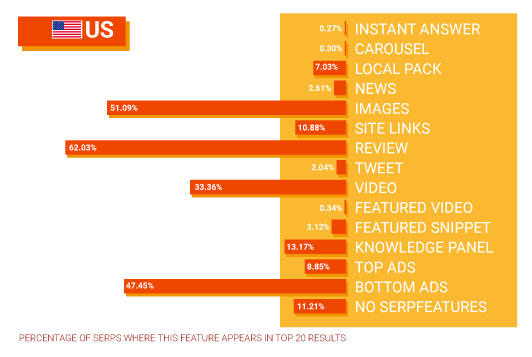
By collecting customer reviews on your site, you can improve your search visibility. The reviews SERP feature will display rating stars and short commentaries from customers, which make search results visually appealing.
To get star ratings on your Google Search results listings, you need to implement the schema.org markup.
According to a BrightLocal survey, 84 percent of people trust online reviews as much as personal recommendations.
But keep in mind that Google checks the credibility of the reviews. You need to ensure they come from your real customers.
To encourage users to leave their feedback, make it easy to review your products on your website. Also, try to find unique and friendly ways to ask them to share their thoughts when they make a purchase.
7. Boost Your Growth With a Strong Link-Earning Strategy
Earning relevant links for your e-commerce website can give your product pages a huge boost in Google’s search results, increasing the visibility of your online store.
In recent years, link building has transformed into relationship building. Think of ways to connect with some influential members of your industry.
For example, you can try to send out some samples of your product for free to your niche review bloggers, who can then post a detailed review. It will help you collect relevant and valuable backlinks and strengthen your brand’s reputation.
Some e-commerce businesses cooperate with other brands in their industry to create mutually beneficial partnerships. They run special offers, providing discounts or coupon codes for related products.
If you use this tactic, don’t give away too much with your offers. Also, you need to ensure that these related products don’t directly compete with your brand.
Interestingly, the most popular anchors used by e-commerce websites are “write a review,” “view,” and “shop now”. While the data provided in the study doesn’t give precise recommendations on how to earn links, e-commerce business owners can use these insights to discover what happens in their niche.
This information will help you better understand how to organize your webpages and build your outreach and link-building strategies.
8. Keep in Mind the Industry Specificity
While some techniques are applicable for any e-commerce business, when planning your strategy it’s crucial to take into account the specificity of your industry.
For example, what works well for electronics might not work the same way for jewelry.
Different companies spend different budgets on marketing and advertising, which influence their strategies.
Generally, businesses with regularly changing product lines tend to spend more on advertising, because they need to inform their customers about product updates on a regular basis.
The same is true for companies that work in highly competitive industries. On the other hand, brands without regular new product launches only need to remind their audience periodically about their special offers.
Of all the niches, the clothing industry invests most heavily in paid advertising: online clothing stores spend 37 percent of their total ad budget on ads (in the $50,000+ range).
Online clothing brands also claim the highest ad spend within the $10,000 to $50,000 range, accounting for 44 percent of their total advertising investment. Meanwhile, online music and book stores spend 84 percent and 75 percent, respectively, of their total ad spend (in the $1,000 or less range).
You can also check data on the amount spent on AdWords among all 13 e-commerce industries in the full version of the research.
Paving Your Own Path Toward E-Commerce Success
There is no proven formula or set of rules for business growth. When building your own marketing strategy, you need to bear in mind multiple nuances related to your niche and your company.
The data provided in the study is for informational purposes only, yet can still help e-commerce business owners make more informed decisions.
Insights into what your most successful rivals are doing give you a better understanding of how to shape your own strategy and reach a new, higher level of success.
More E-Commerce Marketing Resources:
- 10 Awesome Evergreen Content Ideas for E-Commerce Websites
- How to Implement AMP for E-Commerce
- 5 Instagram Tools to Boost Your E-Commerce Sales
Image Credits
All screenshots taken by Ashley Ward (via SEMrush), January 2018




